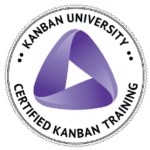KANBAN SYSTEMS
IMPROVEMENT

Manage and Scale Kanban Systems
You learned the basics of Kanban and how to design a single system in the Kanban System Design course. The next step on your journey is to learn how to scale out to multiple connected systems. In Kanban Systems Improvement, you will learn how to manage and optimize those systems using metrics and evolutionary change.
In any workflow system there will be sources of delay, variability, and bottlenecks. Learn to proactively discover these challenges and then apply techniques to improve or smooth the flow of work.

Is Kanban Systems Improvement the Right Course for Me?
If you have not yet completed Kanban System Design (KSD), we strongly recommend you take KSD prior to taking this course. Many people think they have a good understanding of Kanban and can skip directly to KSI, but that rarely works well in our experience. There are many concepts in the KSD course, such as STATIK, work item type, and classes of service, that students need to understand well to take full advantage of Kanban Systems Improvement.
If you have taken KSD and find yourself wondering how to scale, manage or optimize your service delivery, Kanban Systems Improvement is the right course for you.
Duration
In person two day course or 16 hour virtual course.
Pre-Requisites
Attendees are expected to have read “Kanban” by David J Anderson or “Kanban from the Inside” by Mike Burrows.
Certified Training
Participants will receive a certificate of completion for the Kanban Systems Improvement course.
Credential
Students completing this course and the Kanban System Design course receive the Kanban Management Professional (KMP) credential.
What You Will Leave With
- Understand the basics, motivation, and benefits of evolutionary change.
- Scale out your system in multiple directions – upstream, downstream, connected to other systems.
- Learn how to run the Kanban cadences to manage and scale your system across your organization.
- Understand the sources of delays, variability, and what you can do to effectively manage them.
- Identify bottlenecks in a workflow and take actions to improve flow and reduce time to deliver or time to discover.
- Learn how to utilize key metrics such as Lead Time, Run Charts, and Cumulative Flow Diagrams to guide your continuous improvement using evolutionary change.

KANBAN SYSTEMS IMPROVEMENT FLYER
Interested in staying up to date on the latest Kanban News and Resources? Sign up for our mailing list today!






